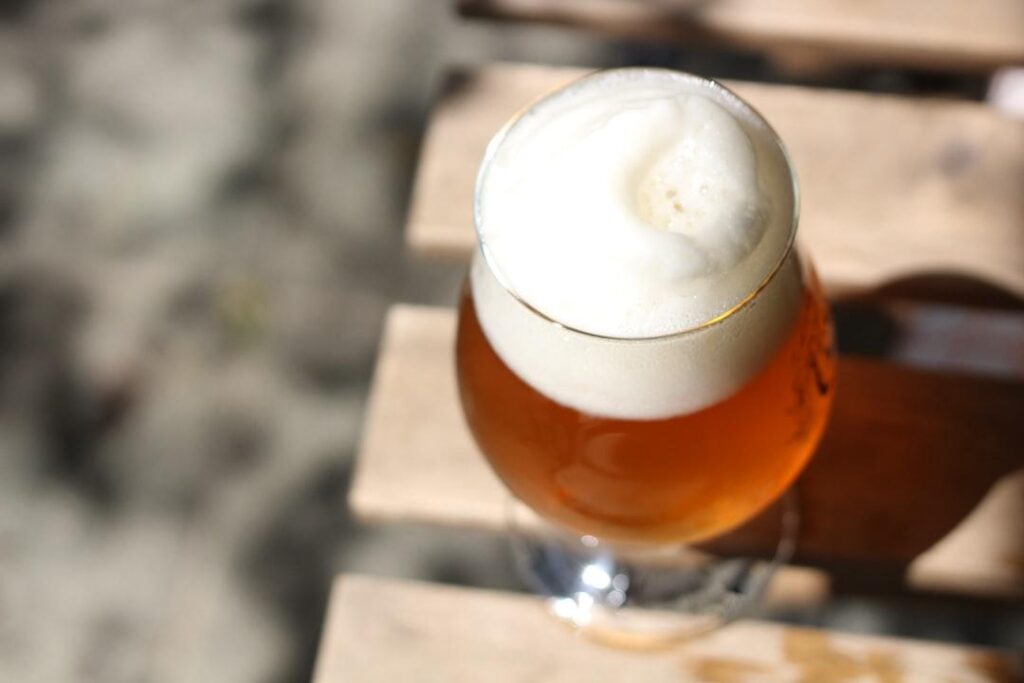Have you ever sat down to enjoy your favorite beer and wondered, “Why does this taste like bananas?” Two words: Isoamyl acetate. This organic compound produces a distinctive banana-like flavor or aroma in beer. And though it’s especially prominent in wheat beers such as the German-style Bavarian weissbier or hefeweizen, isoamyl acetate in beer is considered an off-flavor and most often avoided by brewers. It’s even undesirable in beers such as American lagers that aim for a milder, more flavorless taste.
Most beer contains isoamyl acetate, but in high concentrations, the banana flavor in beer can be overpowering and disrupt the taste of your finished product. Let’s take a look at the role isoamyl acetate plays in the beer brewing process and how you can control the levels of this compound to produce a more subtle flavor.
What Is Isoamyl Acetate and How Does It Form in Beer?
Isoamyl acetate is an ester formed when isoamyl alcohol and organic acids mix. It’s a clear, colorless liquid with a banana-like odor naturally produced by ripening fruit. It’s also one of the most common esters used to flavor foods and beverages, such as candies, cheeses, and, yes, beer.
The compound plays an important role in the overall taste of certain beer styles. And, like all esters in beer, isoamyl acetate is produced by yeast during fermentation. Esters in beer are formed by the condensation of alcohol — such as ethanol, the most abundant alcohol in beer — and a molecule called acetyl coenzyme (acetyl-CoA) in the fermentation process. To produce isoamyl acetate, acetyl-CoA must combine with another alcohol, isoamyl alcohol — creating the banana flavor in beer.
Why Does This Ester Content Produce Banana Off-Flavor?
Isoamyl acetate has a flavor threshold of around 0.6 to 1.2 parts per million. In any amount under this flavor threshold, the amyl acetate flavor is undetectable. But in some cases, the yeast produces too much isoamyl acetate during fermentation and produces a banana off-flavor. This over-production of the ester can be caused by several factors, including stressed yeast, high fermentation temperatures, and low oxygen during the fermentation process.
4 Ways Brewers Control the Levels of This Ester in Beer
There’s no one-size-fits-all solution to producing the perfect amount of isoamyl acetate in beer — or removing it completely. Certain conditions, such as the yeast strain, wort composition, and fermentation temperature, can be manipulated to promote or inhibit ester production.
Below we’ll explore four ways to control the amount of banana ester in your beer:
1. Choosing a Yeast Strain With a Clean Flavor Profile
There’s a wide variety of yeast strains, and the yeast you use will affect the taste of your beer. To avoid producing isoamyl acetate beer, it’s best to choose a yeast strain with a clean, neutral flavor profile — or a “clean” fermenter. Ale yeast strains, for example, have a clean, round profile and low ester production. Using a clean fermenter makes it easier to control the formation of isoamyl acetate and maintain a subtle banana-like flavor.
2. Controlling the Fermentation Temperature
Fermentation temperatures have a significant impact on ester production, as higher temperatures cause yeast to grow faster and produce more esters. In certain yeasts such as Williopsis, isoamyl acetate reaches its maximum yield at 15°C (59°F), while its maximum production rate is at 25°C (77°F).
Fermenting above the recommended fermentation temperature may result in too much isoamyl acetate (creating an overwhelming banana flavor), unwanted esters, or fusel alcohols that make your beer taste “hot.” If the temperature is too cool, you risk losing the desired ester flavor and growing contaminants such as wild yeast and bacteria.
3. Ensuring That the Yeast Is Healthy
A healthy fermentation starts with a healthy yeast, and healthy yeast yields good ester production. Conversely, using a stressed or unhealthy yeast can lead to increased ester levels — including isoamyl acetate — and fusel alcohols.
Yeast is a living organism and, like humans, requires movement, air, and sustenance. And when brewing beer, the goal is to pitch yeast with as close to 100% viability, or live cells, as possible.
Here are a few tips for ensuring your yeast is alive and healthy:
- Keep it fresh: Store yeast in an airtight container in the refrigerator and don’t let it sit on the shelf for too long. It’s best to use it before its expiration date.
- Supply it with oxygen: Healthy yeast requires oxygen, and oxygenating your wort will reduce the amount of isoamyl acetate your yeast produces. Without enough oxygen, however, your yeast will actually produce higher concentrations of esters in the finished beer.
- Keep it fed: Yeast receives most of its nutrients from wort, but feeding it sugar and water can help activate the yeast and ensure its freshness before pitching.
4. Leaving the Beer in the Primary Fermenter for a Longer Period
Beer fermentation starts in the primary fermenter, one of the fermentation vessels, where active fermentation occurs. In this stage, the yeast converts sugar into carbon dioxide gas (CO2) and ethyl alcohol, giving your beer its alcohol content and carbonation.
Aging your beer during primary fermentation gives the yeast extra time to work through undesirable byproducts and off-flavors, including the banana-flavored isoamyl acetate. Acetate esters typically decrease during aging — lowering the concentration of ethyl acetate, isoamyl acetate, and other unpleasant esters — to create a more mellow flavor. In this case, it’s recommended to package your beer three to four weeks after pitching yeast to decrease the amount of banana ester in the beer.
Try the Best Cincinnati Spirits From the Masters of Beer Flavor
Brewing your own beer is a major accomplishment. But it’s not without its challenges, such as ensuring your beer contains the right amount of isoamyl acetate — or none at all.
When you want to experience a done-for-you craft beer in the Cincinnati, Ohio, area, visit us at the Little Miami Brewing Company. Come enjoy our award-winning small-batch craft beer brewed on-site and made with fresh, local ingredients and pair it with artisan pizza baked in our 900-degree brick oven. Drop by our Old Milford brewery today or contact us for event booking and group reservations.




